数码时代的水墨图像
2019-05-26 05:04:15
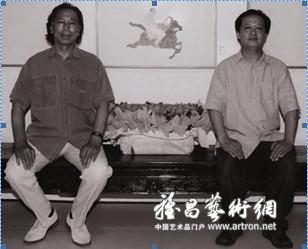
时间:2007年8月22日下午
地点:北京酒厂国际艺术园南溪美术空间
贾方舟:我的第一个问题是先谈谈你的从艺背景。我知道你原来在部队,是先参军后到解放军艺术学院上学的吗?毕业以后就转业了吗?
南 溪:1978年入伍,在江西井岗山地区服兵役,那时开始学山水画,1982年调到北京兵种司令部工作,到了北京眼界开阔了,是1984年才到解放军艺术学院上学。1986年毕业后先到总政文化部协助策划全军美术展览的工作约有六个月,后调到全军老干部俱乐部教高级首长们画中国画。1988年申请转业北京市的指标批准,成为北京市居民。
贾方舟:最早是从什么时候开始画画的?什么时候成为职业画家?
南 溪:中学时图画课不错,那时就画画了。在部队创作组、教授画画都算不上职业画家。我是1991年辞去职务正式在家画画的,日常生活的收入就靠画画。
贾方舟:你画册里有一幅1988年的山水作品,题为《西石沟》。你的简历中说1989年你就在中国美术馆画廊举办过“南溪山水画展”,那些山水画面貌是什么样子的?就是像《西石沟》这一类的作品吗?
南 溪:西石沟是河南巩县的一个村名,这幅作品是用实地写生稿变化创作的,画了好几张这样的系列作品。在中国美术馆画廊举办个展时的有些作品已是走向几何山水图像与接近抽象构成图像了。
贾方舟:看来你对形式语言一开始就很敏感,这件最早的作品已经显露出你在寻找自己的形式语言。山石的皴点具有均衡的人工雕凿的感觉。这种主观化的处理有没有现实依据?
南 溪:山石的几何是从黄山与太行山的峭壁山石中得启发,刚开始我的作品如《五台山》到后来的《风亦城》逐步的变化,直到1995年创作的《吾之山石》。皴点起源是范宽、李唐、龚半千的皴法,临摩了不少,写生创作时也穿插这些皴法去表现山体,后来串合一起画着画着就慢慢地变成了均衡的皴点。
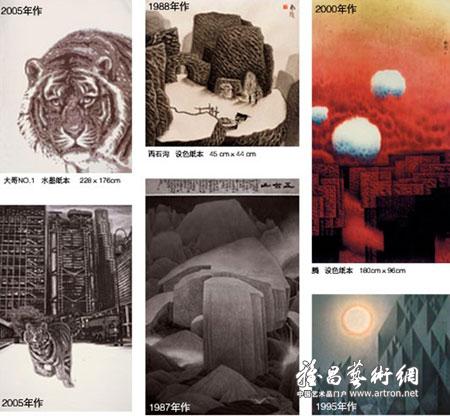
贾方舟:90年代以后,你进一步将山水作几何化处理,将自然人工化的最初动机是什么?仅只是出于形式风格的需要吗?
南 溪:那时我在想,现在的人画山水画图式十分老套,与近二千多年的中国山水画章法差不多,传统山水画的笔法与墨法到了黄宾虹已走到了极致。当代人在继承中国绘画的精华同时应加以改造,使山水画走向当代。
贾方舟:你能给你的艺术演变大体上作一个分期吗?
南 溪:1985—1990年为边学习边创作边创新的时期,技法就是穿插中国画传统的皴点,主要作品有《五台山》、《风亦城》、《西石沟》、《长城》等。
1991—1999年为将山水作几何化处理过程的深入与成熟期,这时期将斧劈皴、折带皴、豆瓣皴等技法混合掺用,时间长了画面的皴点越来越均衡,同时用了山水画的积墨法,层层积染、积点、积皴,所以这时期作品画面看上去很浑厚。主要作品有《吾之山石》、《晖》、《城》、《聚》、《腾》等。
2000—2004年受数码时代的冲击,从电脑软件开发运用中得到启发,我使用Photoshop软件将图像分离转化成水墨作品,掺合了积墨法与泼墨法和破墨法。这期间我在中国水墨画上的主要作用是将数码软件的科学技术较成功地转变为水墨图像,“南氏笔路”在这一时期出现。主要作品《何处是我家》、《家》、《迷茫》、《大哥》等等。
2005年是我运用Photoshop分离法与网点法交汇的时期,在许多幅作品的实验过程中,有不少灵光闪烁的水墨效果展现,我捕捉住了。并一步一步、一块一块深入尝试的耐心研究,“南氏晕点”就在这一时期逐渐形成。也为我2006年一整年几个系列作品出现作了基础的辅垫。
2006—2007年,这一年半时间中我集中了所有精力,去掉许多杂事,专心地去创作,可以说这一年半的时间我的艺术走到了相对的深度,也才能得到您和刘骁纯、吕品田、田黎明、李津、武艺等师辈同仁们的肯定。
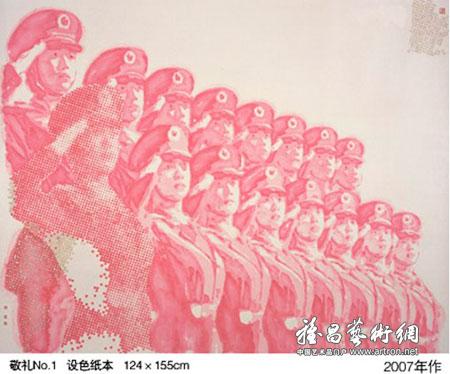
贾方舟:根据你的叙述,我觉得基本上可以概括为三个阶段:80年代后期为第一个阶段,90年代为第二个阶段,2000年到现在为第三个阶段。这第三个阶段是你在艺术上的一个飞跃期。因为正是在这个阶段,你在
数码科技与水墨画的结合上成功地将Photoshop分离图像和网点图像转换成中国水墨画作品,是这方面你是最早也是最成功的艺术家,从而使你的水墨语言与传统拉开距离,具有数字化图像时代的显著特征。但这种时代特征又没有割断与传统的血脉联系,例如你的几个发展阶段始终贯穿的一个基本语素是“点”,直至发展成你特有的一种“笔墨方式”和视觉符号。你觉得“点”是否贯穿于几个不同阶段的一个主要因素?并从传统绘画的启示而来?
南 溪:是的,“点”是贯穿于几个不同阶段的一个主要因素。学习龚半千、“米氏父子”的作品也是启示我使用“点”的因素之一。
贾方舟:刘骁纯把你近几年的作品分为:红色波普图像,时尚流行图像,围棋残局图像,老虎图像,马术图像,是这样吗?是否还应该有一类纯抽象的图像?我觉得这一个类型的作品虽然不多,但很重要。不知你以为如何?
南 溪:您说得很对,纯抽象的图像,几何山石图像,我研究十几年,这类作品实际是形成今天其它图像的基础。我很喜欢几何山石图像,停了好几年没有画了,现在贯穿回看,觉得又有深入研究的方向了。
贾方舟:刘骁纯从技法意义上用“南氏晕点”、“南氏笔路”来概括你的笔墨特点,我觉得都是在语言层面上对你的艺术的很高评价。而我对你的艺术所看重的也是这点。 我认为,从水墨语言的层面看,你的探索已经在不自觉中将自己引领到一个纯粹的语言状态。在这里指出这一点之所以重要,是因为,你从这个基本单元中发现了它所具有的丰富内涵。可以说,对于表现本身的价值确认,是任何一门艺术演进的必然归宿。正是在这个意义上,你的探索具有了本体论的意义。但从你的作品看,这种纯粹的语言状态并不能让你长久地驻足,你还是希望你的作品有一种现实的内容,你能解释这种现象吗?
南 溪:我很敬佩达利、毕加索,他们有不同时期作品与风格,他们贯穿的就是他们自己的艺术本身。我希望自己不是一个复制自己作品的画匠,所以我总不能长久地驻足,去画一个系列就一辈子了,我承认刘骁纯博士说我思想活跃。我的段落时期作品若推到一个相对的极致后,我不想再去画它,或会放一放如几何山石图像。我也不能受藏家及市场的影响去画。我要好玩、我喜欢想象、我爱艺术的冲击力。

贾方舟:我觉得部队生活深刻地影响到你的作品,以及你的趣味。甚至那种整齐划一的山水也与你曾经作为一个军人不无关系。你的《方阵系列》不仅体现出一种集体主义精神,更重要的是体现出你的一种艺术趣味。不知是否可以这样理解?
南 溪:军队的生活经验已烙在了我的生命形式之中。如你所理解的,《方阵系列》等作品可以视为我对集体主义精神的一种表现。在军队服役时我对集体力量有深切的体会,就像阅兵的阵容一样,集体的雄浑气势撼人心魄,会提升一个人的灵魂。我在海外住了很长时间,我真心觉得中华民族应该崛起,希望中国变得更加强大,这需要发扬集体主义精神。当然,艺术不是概念的图解,其实我对“集体”的理解同时伴随着一种强烈的形式感,一种感受于点的集合的恢弘之美。
贾方舟:你对“红色题材”的持久迷恋是否也与这段生活经历有关?
南 溪:选泽“红色题材”当然与我的生活经历有关,但也作了进一步的引申,譬如,如果确实需要的话,我愿意让我的画面吼一声:“雄起吧!中华!”。不过,我对“红色题材”的理解和那些“政治波普”有所不同,就像我爱用曙红和胭脂混合淡墨及其他颜色的灰性红色那样,我力图开掘“红色题材”中的绵长“爱”意或者消除了亢奋情绪的热情感。在我看来,它是社会含义丰富而又特别能够寄托我个人情怀的一种现成的框架,借助大家对它的熟悉,可以拉近我和观者的距离。在某种意义上,我是借助“红色题材”来近距离地“接触”观者,尝试用“红色”来触碰他们情感中的细腻部分。“红色题材”富含社会资源,会引发丰富的审美联想,我想它是值得好好利用的,不必也不该待之以刻意的调侃。
贾方舟:与这类主题截然相反的是那些特别人性化的情色主题,或者说是与“性”相关的主题。除刘骁纯说的“红色波普图像”外的其他几种类型的图像——时尚流行图像、围棋残局图像,马术图像甚至老虎图像都有与情色相关的内容。你自己如何解读你在创作中的这一现象?
南 溪:像对待“红色题材”一样,它也是一种现成的框架,我只想用它拉近我和观者的距离。其中的“情色”或“性”,不必往情色或性上直直地看待,也不必去特别地强调什么。其实,中国人现在早已不觉得它有多么的特别。如果您特别想解读出什么的话,那不妨也把它看作一种绵长“爱”意的表达,当然这就太概念了。当我掌握了“点”的“笔墨方式”后,就不太强调题材了,因为“点”本身可以充分地“说话”可以尽情地“把玩”,我似乎已经太陶醉其中了!
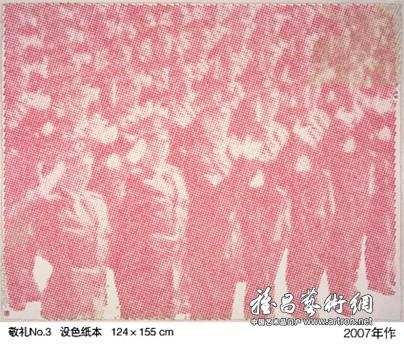
贾方舟:听说你将在年末和李津、武艺在新加坡举办联展。能谈谈这个展览的准备情况吗?
南 溪:这个展览“中国情•李津、武艺、南溪新作展”于11月底将在新加坡余欣美术馆展出。是一个纯学术的展览。我们三人的作品都已备齐,新加坡余欣美术馆还将为此次展览出版画集。这个展览的作品,我用了近一年时间去准备,创作了一组《时尚都市》水墨画的新系列,我也为展览写了篇短文《时尚》,文章中阐述了我的一些想法。
贾方舟:你为什么会选择和这两位艺术家一起作展览?你觉得你们之间有什么共同因素吗?
南 溪:是新加坡余欣美术馆的建议和我们三个人都愿意在一起联展。我觉得三个人的共同因素是相互间的风格、题材等相距很远,互相衬托,使展览丰富有看头。
贾方舟:吕品田用“闲心散游”来概括你们三位的艺术,我觉得李津还差不多,武义勉强算,你完全不是这种心态。“中国情”这个主题只能说还过得去,但不是最叫人眼睛一亮的提炼。因为在你们之间找到一个“公约数”确实太难。不知你以为如何?
南 溪:我前面谈到的都是属于“中国情”的,其实只要生活在中国,就排除不掉“中国情”。展览之所以叫“中国情”就是希望“闲心散游”, 没想过要“叫人眼睛一亮”。也许画了“红色题材”的缘故,你会觉得我完全不是“闲心散游”的心态,看来我们各自调动的“社会资源”有所不同。其实对我来说,“红色题材”有足够的形式感让我“散游”其中,譬如《方阵系列》就是对“矩阵”的利用,它让我的“点”有足够的游走的空间。这种形式上的贴合,让我心理很轻松,这恐怕就是一种“闲心”状态吧。我觉得,吕品田用的“闲心散游”,既适合李津和武义,也适合我,所不同就是我的题材容易会给人以“工作感”,但这并不是我想给别人的。实际上,我真是想带观众到“红色矩阵”中分享我的“点点”快乐和“点点”趣味的。找我们三个人的“公约数”确实不太容易,但我们三个人却彼此投缘,这之间肯定有某种“公约数”在起作用。我想那“公约数”可能还是大家对待生活和艺术的一种态度,也许我们都看重好玩吧。
贾方舟:那还不如叫“三足鼎”呢——开个玩笑!请问下一步还有什么新的计划?
南 溪:正在装修北京宋庄南溪工作室,住到那儿时准备更深入研究红色波谱图像和围棋残局图像等。因为新的工作室比较大,很有施展空间。我的作品画好后没有足够的视觉距离去审读就很难再深入创作,很难达到我想要的作品极致。把我的想象力、创造力展现出来,把水墨的晕点、笔路研究到一个自己满意的深度,也就是像您所说的“纯粹的语言状态”上更进一步的探索,是我今后几年的计划。
贾方舟:愿你不断向着你的艺术理想攀登。
Ink-wash Image in Digital Age
--- an interview of Nan Xi
Jia Fangzhou
Time: afternoon of Aug 22,2007
Site: Nan Qi art space in International Art Park of Beijing Brewery.
Jia Fangzhou as Jia, Nan Qi as Nan in the following conversation:
Jia: My first question would go to your art background. I know you were in the army originally; did you first join the army and then study in the Liberation Army Art Institute? Were you transferred to civilian work after your graduation?
Nan: I joined the army and took the military service in Jinggangshan of Jiangxi province in 1978 from when I began to learn how to draw ink-wash painting. In 1982, I was transferred to work in Arms headquarters in Beijing where I broadened my horizon. In 1984, I went to study in Liberation Army Art Institute. After the graduation in 1986, first I worked six months in general political cultural department to assist the planning of entire army art exhibition, later I was moved to army club for retired cadres to teach senior officers Chinese painting. In 1988, I got approved and became a citizen of Beijing.
Jia: When did you start painting? And when did you become a career painter?
Nan: I was doing great in middle school’s painting class and then started painting. I could not be called career painter neither as originator in the army nor as painting teacher. I stayed at home painting after quitting my job in 1991 and made a living by painting.
Jia: in your 1988 work there is a landscape called “West stone channel”. From your CV we know you held a “Nan Xi landscape exhibition” in Chinese Art Gallery in 1989. What were they look like, the kind of style like “West stone channel”?
Nan: West stone channel is a village name of Gong County in Henan. This painting is created from spot sketches which I had series of them. Some works from that art gallery exhibition are close to geometry landscape image and abstract structure image.
Jia:You seem to be quite sensitive to formal language from the very beginning. This early piece has revealed you are looking for formal language of your own. The skill of landscape dot is of the feeling of balanced artificial sculpting. Do you have any material base for this subjective handling?
Nan: I got inspiration of geometry landscape from the barranca of Mount Huang and Mount Taihang. The changes from early work like “Mount Wutai” to later “Like wind, like city” to “Our Mountain” of 1995. The origin of this dot skill is copied from Fan Kuan, Li Tang and Gong Banqian. I also interlude this skill to express mountain body when doing spot sketch. Gradually it evolved to balanced dots.
Jia: After late 90’s, you did further treatment to geometry landscape, what is your original motivation to artificialize the nature? Is it just out of the need of style?
Nan: I was thinking at that time, the way of modern people’s drawing ink-wash is stereotyped, almost the same as two-thousand-years’ ago. Huang Binhong has reached the peak of brushwork and ink of traditional ink painting. Modern people should reform to accommodate modern age when inheriting the essence of Chinese painting.
Jia: Could you separate your art piece by stage?
Nan: 1985-1990 was the period of learning and creating. The skill was to interlude traditional Chinese dot. Main works include “Mount Wutai”, “Like wind, like city”, ”West stone channel”, “Great Wall”, etc.
1991-1999 was the period of penetrating and mature of geometry treatment. During this period I combined axe-cleaving skill, band-breaking skill and bean petal skill together which make dot even more balanced as time goes by. Meanwhile, I took advantage of ink-accumulating skill to make drawing thick and heavy. Main works include: “Our mountain”, “Sunshine”, “city”, “gathering” and “rising”, etc.
2000-2004 was impacted by digital age. I was inspired from computer software development. With Photoshop I separated and transferred image into ink-wash painting in which I mix the skill of ink-accumulating, ink-spraying and ink-breaking together. During this time I successfully applied digital software to ink-wash image and created “The Nan brushwork”. Leading works include “Where is my home”, “Home”, “Lost” and “Older Brother”, etc.
2005 was the joint period of me using separation with Photoshop and consecutive dots. In the process of the experiment of many works, I captured the sparkling moment of ink-wash effect. What’s more, “The Nan brushwork” was formed during this time through in-depth and patient research which laid the basis for my series of works in 2006.
2006-2007 I got rid of many trifles but concentrated all my energy on creation. I could say my art has reached to a certain depth in this year and a half so I got confirmation from you, Liu Xiaochun, Lv Pintian, Tian Limin, Li Jin, Wu Yi and many masters and peers.
Jia: According to what you said, I think it could be generalized to three phases: late 80’s was the first one, 90’s was the second one, 2000 to now is the third one which is also the leaping phase of your art. Because you successfully transferred separation image with Photoshop and consecutive dots into Chinese ink-wash painting on the combination of digital technology and ink-wash painting, this makes you the pioneer and the most successful artist in this aspect and distinguishes you from tradition but be of obvious characteristics of digital age. However, this age characteristic doesn’t cut off its relations with tradition. For example, the basic element always exists in your several phases is “dot”, which eventually becomes a visual symbol and a “painting way” of your own. Do you think “dot” is the main element existing in those different phases? Did you get inspiration from traditional painting?
Nan: yes, “dot” is the main element always existing in those different phases. Learning from Qian Bangong and “The Mi family” is one factor inspired me to use “dot”.
Jia: Liu Xiaochun divided your recent years’ works into: the Red Pop image, the Fashion image, the Go image, the Tiger image and the Riding image, doesn’t he? Do you have another type of pure abstract image? I think even they are not so many, it is important, do you think so?
Nan; You are absolutely right, I have studied in pure abstract image and geometry mountain stone image for a dozen of years, they are the foundation of other images. I like geometry mountain stone image a lot. After several years of stoppage, I looked back and realized my next researching direction.
Jia: Liu Xiaochun generalized your characteristics with “The Nan Dot” and “The Nan Brushwork” in technique sense. I think they are very high praise for your art in words. In my opinion, from the language of ink-wash painting, your exploration has subconsciously led yourself into a pure language status. What makes this so important is because you found the abundant connotation of this basic unit. In other words, it is the destiny of every art evolution to verify the value of performance itself. In this sense, your exploration has the significance of ontology. However, it seems you are not satisfied with this pure language status, you are expecting some practical content in your works, could you explain this phenomenon?
Nan: I adore Dali and Picasso a lot. Their style and works differs in different time. What they canonized is their art itself. I am expecting myself more than a limner of copying my work. I can not satisfy a series of work for the rest of my life. I accept doctor Liu Xiaochun’s speaking me of being dynamic in thinking. Every time my phase work reaches a peak, I will not paint the same anymore, just like geometry landscape. Moreover, I am not painting on the influence of collector and market. I love fun, imagination and the impact of art.
Jia: I think you are greatly influenced by army career, so is your taste. Even the neatly and orderly mountain and water is quite related to your army life. Your “Phalanx Series” not only reveal a spirit of collective, but also your artistic taste. Am I right?
Nan: Military experience has deeply engraved in my life. Like your understanding, “Phalanx Series” could be considered as my expression of collective spirit. I have deep understanding about collective spirit when serving in the army. Just like the lineup of parade, the powerful force of collective is so strong that one can be sublimed in soul. I lived oversees for quite a long time. I think collective spirit matters a lot in the grow-up process of china. Certainly, art is not a illustration of concept. My understanding of “collective” is accompanied by a strong sense of form and a powerful beauty of the gathering of dots.
Jia: Is your long-term obsession to “The Red Material” related to this life experience?
Nan: Choosing “The Red Material” is certainly related to my life experience but not limited to that. For example, I would like my work to below: “Come on, China!” if necessary. But my understanding to “The Red Material” is different to those “political Bop”. Just like I prefer to use red and rouge to mix light ink and other grey red, I tried to explore the continuous “love” from “The Red Material” to get rid of exiting enthusiasm. In my point of view, it is a ready framework with rich social connotation and carries my individual ideal. I could shorten my distance with audiences if one gets familiar with it. In a sense, I am trying to “reach” audiences closely with the help of “The Red Material” and touch their subtle part of emotion with “red”. “The Red Material” is of social sources so it can ignite rich aesthetic imagination. I think it deserves better usage, deliberate tease is not necessary.
Jia: What on the contrary is those human pornographic theme or “sex” related topic. Besides the Red Pop images divided by Liu Xiaochun, other images like the Fashion images, the Go images and even the Tiger images include some content related to pornography. How do you paraphrase this phenomenon of your creation?
Nan: It is a ready framework just like “The Red Material”. My purpose is to shorten the gap between me and the audience. Speaking of “pornography” and “sex”, it is not necessary to directly imagine sex nor to stress anything. As a matter of fact, this is not fresh to Chinese audiences. If you really want to figure out something, try to consider it as an expression of continuous “love”, it is a concept though. After I mastered the “brushwork” of “dot”, material is not the key factor. As “dot” can adequately “express” itself and “exercise” as much as I like. I enjoy it so much.
Jia: It is said you are going to have an united exhibition with Jin Li and Yi Wu at the end of the year. Could you talk something about the preparation work for it?
Nan: This exhibition named “Chinese affection•new works of Jin Li, Yi Wu and Xi Nan” will be held in Yuxin gallery of Singapore at the end of November. It is simply an academic exhibition. We three are ready for it. That gallery will publish painting collections for this exhibition. I prepared for this exhibition for almost a year and created a new series of “Fashion& city”. I also wrote an article named “Fashion” for this exhibition, in which I explained my idea.
Jia: Why did you choose to hold an exhibition with those two artists? Do you think you have something on common?
Nan: It is suggested by Yuxin gallery of Singapore and agreed by us. I think our common lies in that our style and material differs so much that makes this exhibition colorful and attractive.
Jia: Pintian Lv summarized you three with “roaming leisure heart”, but I think only Jin Li fits this category, Yi Wu is reluctantly of it, and you totally not belong to this. “Chinese affection” is average, not so eye-catching. Is that because it is too hard to find a “common divisor” among you three?
Nan: All I talked about just now belong to “Chinese affection”. In fact, you can never escape from “Chinese affection” as long as you still live in china. The reason it is called “Chinese affection” is that the exhibition is expected to be a “roaming leisure heart” in stead of “eye-catching”. You may think of me not in this mood because of “The Red Material”. It seems we have mobilized different “social resource”. For me, “The Red Material” has enough sense of form to let me “roaming” inside. For instance, “Phalanx Series” take advantage of “matrix” and leave adequate space for my “dots”. The joint in this form makes me feel at ease. I think this is so-called “leisure heart”. “Roaming leisure heart” proposed by Pintian Lv fits not only Jin Li and Yi Wu but me. The only difference is my material has the sense of “work feel”, but this is what I want to give. What I really want to do is to lead audience to “The Red Matrix” and share my happiness and taste of “dots”. It is hard to find a “common divisor’ among us but we get along with each other quite well. There must be some kind of “common divisor” working here. Maybe that is people’s attitude towards life and art but we focus much more on fun.
Jia: Sounds like “Status of three-way struggling for hegemony”----just kidding. What is your next plan?
Nan: My studio situated in Song Village of Beijing is under decoration which is so spacious that I am planning to do further research on the Red Bop image and the Go Endgame image. It is hard to do further creation within confined space cause my work needs enough visual space to examine after finishing. My plan for next few years would be exert my imagination and creation to a satisfactory depth in the research of ink dot and brushwork, just like what you called “pure language state”.
Jia: Wish you go well on the way to artistic ideal.

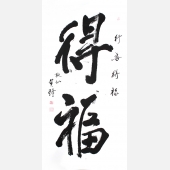 黄琦
黄琦 武中奇
武中奇 测试用艺术
测试用艺术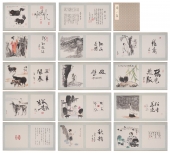 尼玛泽仁
尼玛泽仁




